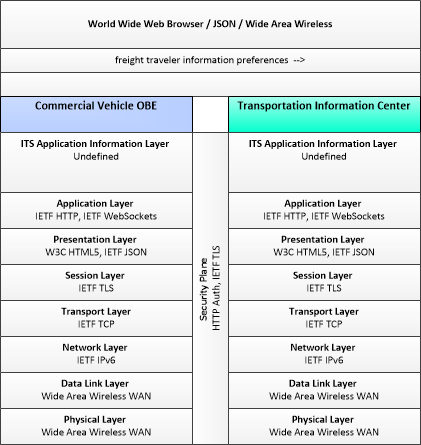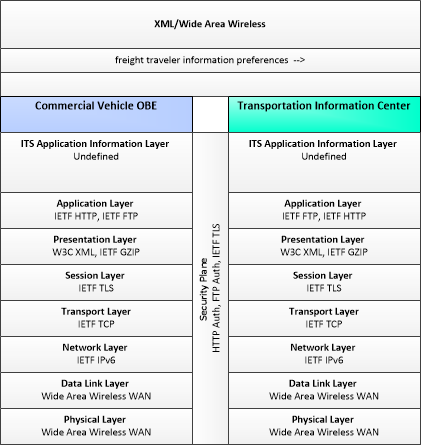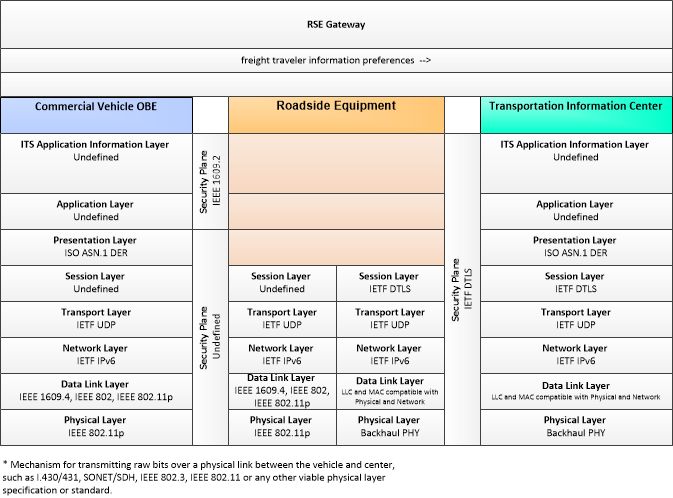Link Type: Wide-Area Wireless
Commercial Vehicle OBE --> Transportation Information Center:
freight traveler information preferences
Definitions
freight traveler information preferences (Information Flow): Traveler information preferences from fleet and freight management systems or commercial vehicle drivers including: area covered by fleet/driver, types of freight managed (including special restrictions), preferred routes, other travel preferences pertaining to trip costs or tolls.
Commercial Vehicle OBE (Source Physical Object): The Commercial Vehicle On-Board Equipment (OBE) resides in a commercial vehicle and provides the sensory, processing, storage, and communications functions necessary to support safe and efficient commercial vehicle operations. It provides two-way communications between the commercial vehicle drivers, their fleet managers, attached freight equipment, and roadside officials. In CVRIA, a separate 'Vehicle OBE' physical object supports the general V2V and V2I safety applications and other applications that apply to all vehicles, including commercial vehicles. The Commercial Vehicle OBE supplements these general capabilities with capabilities that are specific to commercial vehicles.
Transportation Information Center (Destination Physical Object): The 'Transportation Information Center' collects, processes, stores, and disseminates transportation information to system operators and the traveling public. The physical object can play several different roles in an integrated ITS. In one role, the TIC provides a data collection, fusing, and repackaging function, collecting information from transportation system operators and redistributing this information to other system operators in the region and other TICs. In this information redistribution role, the TIC provides a bridge between the various transportation systems that produce the information and the other TICs and their subscribers that use the information. The second role of a TIC is focused on delivery of traveler information to subscribers and the public at large. Information provided includes basic advisories, traffic and road conditions, transit schedule information, yellow pages information, ride matching information, and parking information. The TIC is commonly implemented as a website or a web-based application service, but it represents any traveler information distribution service.
Included In
This Information Flow is in the following Applications:
This Information Flow is in the following Application Objects:
Communication Diagrams
The communication diagram(s) can be viewed in SVG or PNG format and the current format is SVG. Switch to PNG format.
This profile describes applicable XML and W3C web services standards used in transmissions over wide area wireless communications.
This profile describes applicable ASN.1 standards used in transmissions over wide area wireless communications.
This profile describes an alternative set of standards used in vehicle communications where one or more RSEs act as a gateway with the vehicle as source.
Characteristics
Architectural:
| Characteristic | Value |
|---|---|
| Time Context | Historical |
| Spatial Context | Regional |
| Acknowledgement | False |
| Cardinality | Unicast |
| Initiator | Source |
Security
This information flow triple is in the following applications with the following security levels.
| Information Flow Security | |||||
|---|---|---|---|---|---|
| Application | Confidentiality | Integrity | Availability | ||
| Basis | Basis | Basis | |||
| Security levels have not been defined yet. | |||||



